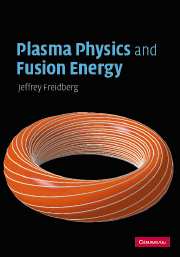Book contents
- Frontmatter
- Contents
- Preface
- Acknowledgements
- Units
- Part I Fusion power
- Part II The plasma physics of fusion energy
- 6 Overview of magnetic fusion
- 7 Definition of a fusion plasma
- 8 Single-particle motion in a plasma – guiding center theory
- 9 Single-particle motion – Coulomb collisions
- 10 A self-consistent two-fluid model
- 11 MHD – macroscopic equilibrium
- 12 MHD – macroscopic stability
- 13 Magnetic fusion concepts
- 14 Transport
- 15 Heating and current drive
- 16 The future of fusion research
- Appendix A Analytical derivation of 〈ς v〉
- Appendix B Radiation from an accelerating charge
- Appendix C Derivation of Boozer coordinates
- Appendix D Poynting's theorem
- Index
- References
11 - MHD – macroscopic equilibrium
Published online by Cambridge University Press: 14 May 2010
- Frontmatter
- Contents
- Preface
- Acknowledgements
- Units
- Part I Fusion power
- Part II The plasma physics of fusion energy
- 6 Overview of magnetic fusion
- 7 Definition of a fusion plasma
- 8 Single-particle motion in a plasma – guiding center theory
- 9 Single-particle motion – Coulomb collisions
- 10 A self-consistent two-fluid model
- 11 MHD – macroscopic equilibrium
- 12 MHD – macroscopic stability
- 13 Magnetic fusion concepts
- 14 Transport
- 15 Heating and current drive
- 16 The future of fusion research
- Appendix A Analytical derivation of 〈ς v〉
- Appendix B Radiation from an accelerating charge
- Appendix C Derivation of Boozer coordinates
- Appendix D Poynting's theorem
- Index
- References
Summary
The basic issues of macroscopic equilibrium and stability
The first major issue in which self-consistency plays a crucial role is the macroscopic equilibrium and stability of a plasma. One needs to learn how a magnetic field can produce forces to hold a plasma in stable, macroscopic equilibrium thereby allowing fusion reactions to take place in a continuous, steady state mode of operation. This chapter focuses on the problem of equilibrium. The issue of stability is discussed in Chapters 12 and 13.
The analysis of macroscopic equilibrium and stability is based on a single-fluid model known as MHD. The MHD model is a reduction of the two-fluid model derived by focusing attention on the length and time scales characteristic of macroscopic behavior. Specifically, the appropriate length scale L is the plasma radius (L ∼ a) while the appropriate time scale τ is the ion thermal transit time across the plasma (τ ∼ a/vTi). This leads to a characteristic velocity u ∼ L/τ ∼ vTi, which is the fastest macroscopic speed that the plasma can achieve – the ion sound speed.
The derivation of the MHD model from the two-fluid model is the first topic discussed in this chapter. Also presented is a derivation of MHD starting from single-particle guiding center theory. The purpose is to show that the intuition leading to MHD is indeed consistent with single-particle guiding center motion.
- Type
- Chapter
- Information
- Plasma Physics and Fusion Energy , pp. 245 - 295Publisher: Cambridge University PressPrint publication year: 2007
References
- 1
- Cited by



